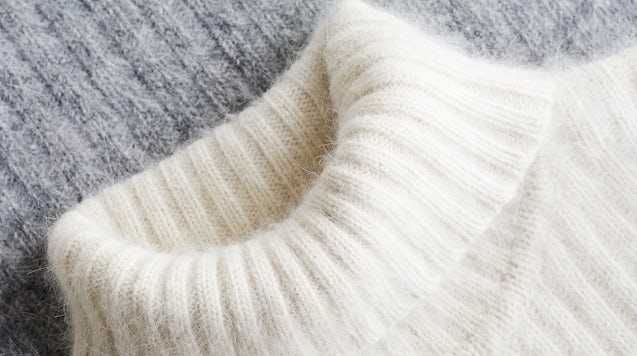Made from the softest wool produced by a certain breeds of goats, such as the Zalaa Ginst white goat and Tibetan Plateau goat, cashmere was once reserved for the wealthiest fashionistas. (Napoleon Bonaparte’s wife helped popularise the fabric.) But over the past two decades, its cachet skyrocketed and cheaper garments flooded the market.
Nearly $1.4 billion of cashmere garments were exported globally in 2016, up from $1.2 billion in 2010, according to United Nations trade data. That's nearly 5 million kilograms worth of pullovers, cardigans, and other tops. Now it’s seemingly everywhere, at every price point. Ubiquity can spell trouble for a product as it becomes more of a commodity, especially one that’s been historically marketed as a luxury item.
So what makes one sweater better than another? The price depends on the quality of the yarn, where the garment was manufactured, the number of units purchased by the brand, and the markup.
The quality of the raw material often matters most. Lengthier cashmere fibers maintain their integrity for a longer time, allowing garments to retain their structure. Pilling — the small balls that form on the fabric as it chafes — is more common in garments made of shorter cashmere strands. These days, manufacturers frequently make the clothes out of a mix of lengths to balance quality with cost.
Ubiquity can spell trouble for a product that's been historically marketed as a luxury item.
The thickness of the yarn used for the fabric determines its durability. So-called single-ply yarn is the weakest and can quickly lead to holes in a favorite sweater. Higher-quality cashmere pieces are typically two or three strands thick.
Finer and smoother individual strands create softer garments, but they are rare and thus, cost more. American consumers value this softness above all else.
“The customer cares more about the hand-feel than they care about the durability or the color saturation,” said Matt Scanlan, chief executive officer of sustainable cashmere label Naadam. “They don’t even care if it starts to pill. We’ve just become used to it.”

Cashmere goats are bred in various locations around the world, including Australia, China, and Mongolia, but Scotland and Italy are known for cashmere-manufacturing prowess. Luxury fashion houses such as Loro Piana and Brunello Cuccinelli depend on the expertise of their workers to wash, treat, and refine the fabric. Cashmere, for instance, repels a lot of dye. Italy, however, has developed ways to achieve strong saturation.
Not every manufacturer takes such care. Blended versions of cashmere sweaters, available at most retailers these days, can contain varying quantities of the fabric. In some cases, as little as 5 percent of a garment is made from the good stuff, with the rest a combination of mass-market fabrics such as polyester or nylon. The product is still marketed as a “cashmere-blend.”
Shoppers have slowly gotten used to lower-quality product.
Occasionally, even fake cashmere makes it to store shelves. "There is certainly fraud on this front,” says Frances Kozen, a director at the Cornell Institute of Fashion and Fiber Innovation. Deceitful sellers and counterfeiters sometimes create cashmere blends labeled 100 percent cashmere that contain wool, viscose rayon, and acrylic — and possibly even rat fur, she says.
The lower-quality blends, occasional outright fraud, and ubiquity has diluted cashmere’s luxe reputation, and shoppers have slowly gotten used to lower-quality product.
The industry is attempting to rehabilitate the fabric’s reputation by educating consumers as to where cashmere comes from. Naadam, Scanlan’s cashmere label, assures customers that it uses only the longest fibers, promising that this will make the garments last longer. The label touts its sustainable grazing practices and lack of chemicals or bleaches. Sweaters from Naadam aren’t cheap, going for $125 to $225, so the brand must show shoppers why it’s worth their cash.
“Cashmere still has a lot of meaning for people, even though a lot of brands have bastardized what a lot of words mean,” says Shilpa Shah, co-founder of clothing and accessories label Cuyana. The brand’s cashmere sweaters are manufactured in Scotland and Italy and cost from $155 to $495. They don’t match up to the quality of what you’ll find from designers at a much higher price, but Shah insists they get close.
As for the lesser-quality cashmere being sold, Shah has an optimistic view: At least shoppers are trying some kind of cashmere and may seek out better versions. “In some sense, I should be thanking them,” Shah says of the cheap cashmere sellers, “because it’s an introduction to what the material could be.”




0 Yorumlar